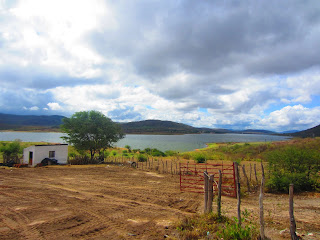Saturday, May 26, 2012
Today is Friday, May 25th and my students, Lee (from Global Citizens Network), and I spent the day with Cacique Marquinho, who woke us up early to show us the total perimeter of the Xukuru lands. Helena had coffee, French bread, butter, and fruits for us to eat for breakfast. We began our tour in the Aldeia (village of Santana where Marquinho lives) and drove to the following aldais: Corodantas, Coral de Boi, Cimbres, Jatoba, Coral Velheo, Passagem, Calderao, Pao de Acuca, Pe de Serra dos Nogeira, Pe de Serra de Sao Sebastao, Capim de Planta, Canna Brava, and back to Santana.
Cimbres is a historic city with the church Nossa Senhora das Montanhas. This church was central to the attempted assassination of Cacique Marcos Xukuru because it has been part of an ongoing battle between local politicians, businessmen, and a small number of Xukuru. This is another story, which I'll tell later.
The total tour took us approximately six hours. As we passed through each aldeia, Marquinho stopped and talked to everyone we passed, usually because everyone has some kind of problem or issue they needed to talk to him about. That gave us an opportunity to meet many local people, learn about the issues that needed attention in each aldaia, and to get out of the car and walk around or take pictures. I'm posting photos of our tour with this short post. The Xukuru territory is large, but today there almost 12,000 Xukuru living on 27,555 kilometers. There is a growing need to expand the territory that they currently have. On our tour we saw how the Xukuru are developing various agro-petrol projects for alternative combustible fuels. The Brazilian government is interested in developing a variety of new types of fuel for cars and trucks and for industrial use that includes a plant called 'mamona'. They already have an enormous production of fuel made of sugar cane that is the major type of fuel for Rio de Janeiro and a variety of other urban centers.
This is the 'mamona' plant:
The spiny balls at the top of the 'mamona' plant is used to make fuel for cars.
This is the fruit called graviola:
When you break open the fruit it is white, with seed packets that are sweet and juicy. The packets have a shiny, black seed that can be used to make jewelry.
In the area of Calderao, a large project is underway to transform the land. Most of the Xukuru lands were denuded due to cattle ranching and over the last 11 years they have been reforesting the land with native plants and with fruit trees and types of vegetables that grow well in this area and that don't rob the soil of it nutrients. in Calderao (in the Rebiera, and area that has enough water to plant and grow crops) they are planting many fruit trees (papaya, bannana, goiaba, graviola), lettuce, carrots, onions, beans, corn, cilantro, and coconut trees. This area is a model project for this area of the Xukuru land. There are three regions with three different climates: Serra (wet), Rebiera (less water than the Serra, but enough to do successful agriculture), and finally Agreste (dry - grow food for cattle that is called "palma" and is a kind of cactus).
Each climate zone must be understood in terms of the types of vegetation that naturally and historically grow there, and in terms of future plans that seek to increase production while also protecting the soil through the use of sustainable organic agriculture. The Xukuru are working to increase their production while maintaining their collective way of life which includes making decisions about all aspects of their community life. The foundation from which all decisions are made is the fundamental knowledge and acknowledgement that the earth is sacred and that life depends on an interdependence between the natural cycles of nature, the interrelationship between humans, animals, plants, and the environment, and an unwavering respect for nature.
My students will be writing about their experiences today and are also including photos that they took on our trip.
---------------------------------ERIN: 5/25/2012
Today Cacique Marcos took us on tour of the Xukuru territory. On the tour you could see how charismatic, kind, and reliable he is. As we went on our tour Cacique would stop to talk to people, he seemed to know everyone and treat everyone like a family member, because the Xukuru people are like a family they take care of each other and share there resources as well as talents with everyone in the community.
I also found it very interesting how the territory is able to communicate, the territory is very large and the road are very poor making it hard to get around. Some of the villages only have one telephone. People use word of mouth or travailing nurses to help communicate.
Posted by
Marcia Mikulak - Associate Professor, University of North Dakota Dept. of Anthropology
at
12:25 AM


Subscribe to:
Post Comments (Atom)






No comments:
Post a Comment